Information in the review is provided as of May 1, 2024
Summary
The combat readiness inspection remained the main military event of April in the Belarusian Armed Forces. As part of the inspection, the mobilization expansion of two brigades – a mechanized brigade and an anti-aircraft missile brigade – is being practiced. The combat readiness inspection continues and remains the largest in the history of the Belarusian Armed Forces.
The level of presence of the Russian Armed Forces practically didn’t change in April. There may be about 2000 Russian military personnel in Belarus. There are reasons to believe that part of the contingent stationed in Belarus could have been rotated in April. The aviation group of the Russian Aerospace Forces increased by one fighter jet. The activity of units of the Russian Armed Forces stationed in Belarus remains low.
PMC Wagner mercenaries are still stationed in Belarus, and they continue to train enforcers of the Lukashenka regime. Their number may be estimated at hundreds of people.
The general medium-term forecast of the military situation in Belarus remains the same. Currently, there is no reason to expect an offensive by the Russian Armed Forces from the territory of Belarus, as well as an increase in their military presence. Involvement of the Belarusian Armed Forces in combat operations against Ukraine is still unlikely. The significance of PMC Wagner as a destabilizing factor no longer exists.
Chapter 1. Armed Forces of the Republic of Belarus
1.1. Organization of combat training
The season for combat training activities in the field (primarily field drills) ended in April. The ‘seasonality’ of combat training activities is influenced, among other things, by the timing of the dismissal of conscripts who have served their prescribed terms of service. Intensification of combat training can be expected in the second half of June and early July (after the arrival of new recruits to the troops).
The most large-scale combat readiness inspection in the history of the Belarusian Armed Forces also continued (for more details, see paragraph 1.11 of the review).
Significant combat training activities include the following:
1) Special tactical drills on the topic “Management of reconnaissance forces and means” were conducted in the Western Operational Command. One of the features of the drills was their complexity and work on unfamiliar and unprepared terrain. During the drills, UAVs were used for air reconnaissance.
2) Tactical drills with live firing by air defense units of the Western Operational Command took place at the Damanava training ground. The anti-aircraft missile and artillery divizions of the 6th and 11th Mechanized Brigades, as well as the 147th Anti-Aircraft Missile Regiment, took part in the drills. During the drills, live firing was carried out with the 2S6 Tunguska, Strela-10, Osa and Igla systems. UAVs of various types were used to conduct reconnaissance and record the defeat of aerial targets.
3) Bilateral company tactical drills with live firing by units of the 38th Air Assault Brigade were conducted at the Brestski training ground. The paratroopers practiced a set of tactical tasks on various terrain. Special attention was paid to the work with reinforcement means, the use of UAVs, tactical medicine.
4) A comprehensive training on planning and controlling fire attacks took place at the Obuz-Liasnouski training ground. The training involved units of the Missile and Artillery Troops, reconnaissance, UAVs, electronic warfare and aviation troops. A special feature of the training was the use of the Pustelga aviation guidance automation system.
5) Battalion tactical drills with the 52nd Separate Tank Battalion of the 6th Mechanized Brigade were held at the Hozhski training ground.
6) Training for FPV drone operators began at the base of the 6th Mechanized Brigade.
7) One of the divizions of the 15th Anti-Aircraft Missile Brigade took part in tactical drills. The divizion, armed with S-400 SAM systems, went to a new position area and went on combat duty. The servicemen practiced the issues of occupying launch positions on unprepared terrain, guarding military equipment, marching, countering sabotage and reconnaissance groups of the conditional enemy, etc.
8) On April 22-26, command-staff drills were conducted with military authorities and military technical support units. During the drills, issues related to the management of technical support for troops, the restoration of military equipment, the work of mobile repair crews, and the security and defense of military units of technical support were worked out.
9) Command-staff drills were conducted in the 8th Brigade of Nuclear, Chemical and Biological Protection. During the drills, the units practiced a set of Nuclear, Chemical and Biological Protection tasks, performed aerosol masking of the troop concentration area, conducted chemical reconnaissance, and carried out special treatment of military equipment. Conscripts were drafted from the reserve to take part in the drills.
Training of Belarusian military specialists in Russia
Belarusian military specialists continue to be trained at training centers on the territory of Russia.
1) A group of servicemen of the Belarusian Armed Forces continued training as snipers at the 56th training center for junior specialists of the motorized rifle troops of the Russian Armed Forces.
2) Training of the 7th Separate Tank Battalion of the 11th Mechanized Brigade continued at the 333rd training center in Russia. The servicemen performed firing exercises with the armament of the T-72B3 tank and practiced marching as a platoon. On April 21, the servicemen completed the training and returned to Belarus.
Internal Troops, Border Guard bodies
Significant combat training activities include the following:
1) Special tactical exercises on the topic “Participation of the unit [a brigade] in a counter-terrorist operation” were held with servicemen of the 2nd Militia Brigade of the Internal Troops.
2) The personnel of the 4th Militia Brigade underwent tactical-special exercises on the topic “Actions of the forces of the unit in conducting a counter-terrorist operation”. During the drills, they practiced search and suppression of terrorist organizations and illegal armed groups, repulsion of an attack on the convoy during the march, and organization of protection of the place of temporary deployment.
4) On April 12-20, comprehensive field drills of maneuver groups were held in all border guard units of Belarus as part of the inspection of the border guard agencies by the State Secretariat of the Security Council. The servicemen practiced the issues of preparation for the fulfillment of the assigned tasks, as well as the tactics of special actions.
Training of Belarusian enforcers by PMC Wagner mercenaries
Training of servicemen by PMC Wagner mercenaries continued in April.
It is known that the mercenaries continue to work with servicemen of the Internal Troops systematically. At the same time, this cooperation is not publicly recognized. Earlier we wrote that the press service of the Internal Troops stopped mentioning PMC Wagner in its materials. Since the beginning of February and up to the present time, the mercenaries have been publicly referred to as “experienced instructors.” For this reason, the ongoing cooperation can be assessed by circumstantial evidence (mainly photos and videos). It is known, for example, that mercenaries conducted combat coordination of the Granit special forces detachment in April.
Training also continued with the Belarusian Armed Forces. During April, the mercenaries continued to train the 105th Separate Mechanized Battalion of the 11th Mechanized Brigade. Special attention was paid to studying the experience of the war in Ukraine, including the tactics of assault groups in cooperation with reconnaissance, artillery and UAV units, the use of anti-tank weapons, etc. The training ended with battalion tactical drills.
The 105th Separate Mechanized Battalion became the second mechanized battalion in the Western Operational Command to undergo joint training with the mercenaries. We should note that the Ministry of Defense of Belarus avoids frequent mention of cooperation with PMC Wagner mercenaries.
Thus, the use of PMC Wagner in the organization of combat training remains systematic.
1.2. Movements of military equipment and aviation activity
The main factors that influenced the intensity of movements of military equipment and aviation activity in April were:
- completion of the combat readiness inspection with the 19th Mechanized Brigade and the 120th Anti-Aircraft Missile Brigade (return of units from training grounds and terrain to permanent deployment points);
- completion of the spring “season” of combat training activities (for more details, see paragraph 1.1 of the review);
- the beginning of preparations for the parade dedicated to the 80th anniversary of the liberation of Belarus (to be held in Minsk on July 3).
The intensity of movements of military equipment decreased by one third compared to March. As in previous months, there was nothing unusual in movements of the equipment of the Belarusian Armed Forces. Most of the movements are concentrated in the vicinity of the areas where the garrisons and training grounds of the Belarusian Armed Forces are located. Among the novelties of April, we can note the appearance of movements of equipment of the Belarusian Armed Forces in Yelsk district (for more details, see paragraph 1.3 of the review).
More details on the movements of military equipment are available on the map of military activity.
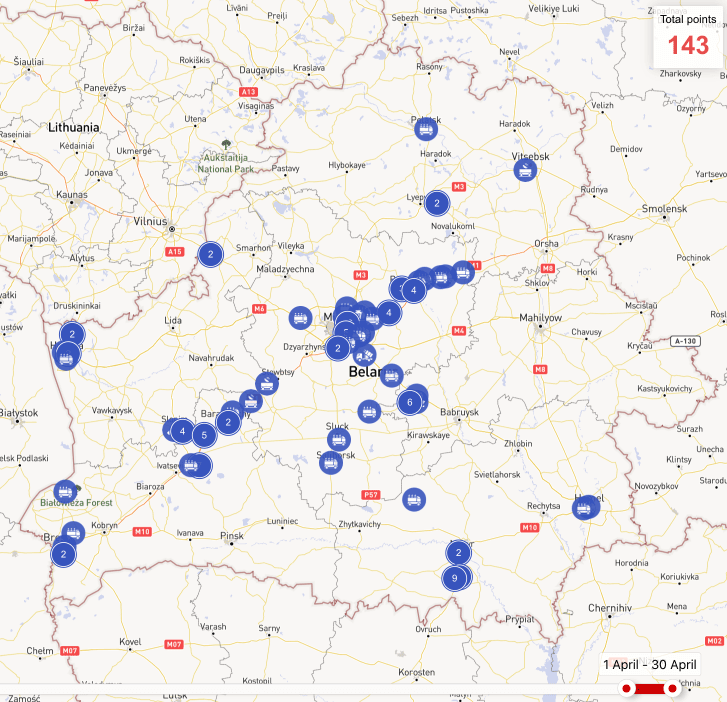
The intensity of movements of the Belarusian Armed Forces by rail didn’t change compared to March. The following railway stations were used during the movements: Liasnaya, Asipovichy-1, Zaslonava, Palonka, Aziaryshcha, Slonim, Brest-Uskhodni, etc. Military cargo trains with equipment of the Belarusian Armed Forces were recorded in Brest, Barysau, Hrodna, Babruisk, etc.
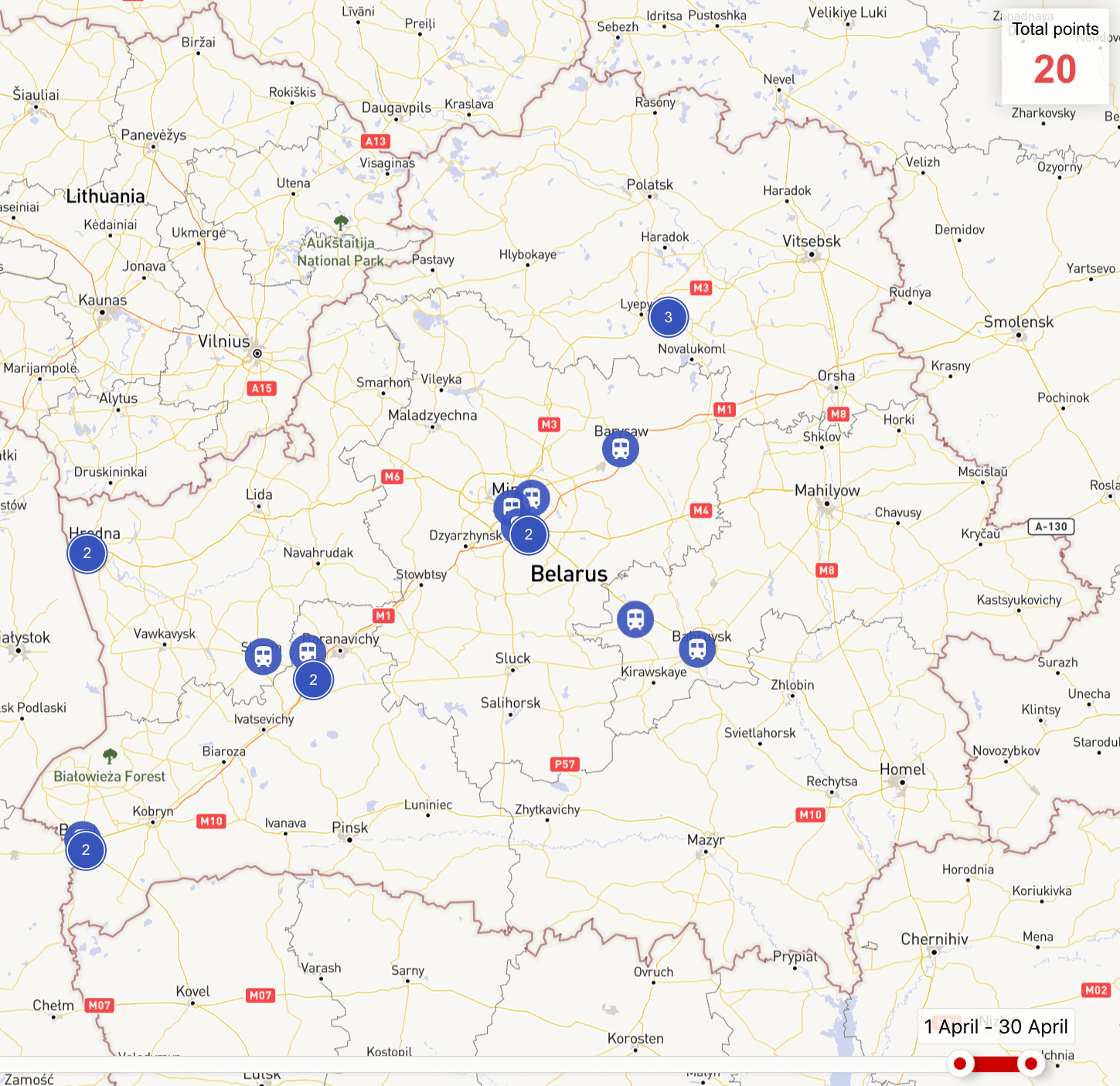
The intensity of flights of the Belarusian Air Force remained at the same level compared to March. Lida, Baranavichy and Machulishchy airfields were mainly used for flights, while Vosautsy, Luninets and Babruisk airfields were used less frequently.
The following notable features of aviation activity can be noted:
1) During the month (on April 7, 8, 11-14, 16-23, 25-28), flights of helicopters of the Belarusian Air Force were repeatedly recorded in the area of the state border with Poland.
2) Flights of a Mi-8 helicopter of the Belarusian Air Force were recorded twice (on April 4 and 16) in Ros’ village (Vaukavysk district). There is an abandoned military airfield in the vicinity of the village, as well as the 3rd radio-technical center of the 2285th Separate Radio-Technical Battalion of the Belarusian Armed Forces.

4) On April 25, the head of the State Security Committee of Belarus, Ivan Tsertsel, said that the special services of Belarus had prevented UAV strikes from the territory of Lithuania against the facilities in Minsk. No facts that would confirm the prevention of UAV strikes (for example, the use of the Belarusian Air Force) were provided.
1.3. A group of the Belarusian Armed Forces deployed in the border regions of Belarus
Regions bordering Ukraine
Units of the Special Operations Forces are still deployed in the regions of Belarus bordering Ukraine. Despite the fact that the military are officially declared to be performing border protection tasks, at the same time they are covering Russian military facilities in Homiel region.
As of the end of April, one of the battalions of the 103rd Airborne Brigade was deployed in the vicinity of Ziabrauka airfield (Homiel district). In turn, one of the detachments of the 5th Special Forces Brigade continues to be stationed in the vicinity of Mazyr.
It is known that another rotation took place on April 19-21, during which a battalion of the 38th Air Assault Brigade was replaced by a battalion of the 103rd Airborne Brigade. On average, the rotation of units of the Special Operations Forces deployed in the regions of Belarus bordering Ukraine takes place every two months. The previous rotation of units took place in late February-early March 2024.
The total number of these units can be estimated at 400-500 people.
We recall that units of the Special Operations Forces will be stationed in Mazyr and Homiel districts until the end of 2024.
Currently, there are no reasons to believe that the number of the group of the Belarusian Armed Forces near the border with Ukraine may increase. The number of units located there is static.
Protection of the Mazyr oil refinery
On April 8-9, units of the Air Defense Forces of the Belarusian Armed Forces – the 1146th Anti-Aircraft Missile Regiment, military unit 97106, and the 147th Anti-Aircraft Missile Regiment, military unit 96869 (one battery of each regiment – Tor-M2K and Osa-AKM SAM systems, respectively), were redeployed to Yelsk district (Homiel region). We constantly record the activity of the Belarusian military in Yelsk district.
Air defense units are stationed both in Yelsk itself and in the vicinity of Palouki village, which is located 3 kilometers from the Mazyr oil refinery.
According to our information, the redeployment of air defense units to Yelsk district is connected with covering the Mazyr oil refinery from potential UAV strikes. This was confirmed by Lukashenka himself on April 12. He said that he had given the military the task to take the refinery under guard. It is notable that the 1146th Anti-Aircraft Missile Regiment permanently performs the task of protecting another strategic facility – Belarusian NPP. In other words, covering the Mazyr oil refinery is to the detriment of the NPP’s protection.
According to preliminary information, units of the 147th Anti-Aircraft Missile Regiment will stay in Yelsk district until the end of April, and units of the 1146th Anti-Aircraft Missile Regiment – until the end of 2024 (with possible extension or reduction of the period of military presence there). Therefore, the nature of the threats to the security of the Mazyr oil refinery was recognized as permanent.
Most likely, the units of the 1146th Anti-Aircraft Missile Regiment will be stationed in Yelsk district on a rotational basis, as is the case with units of the Special Operations Forces in Homiel region (see details above). We note that the regiment has five Tor-M2K SAM batteries, which ensures the possibility of regular rotations.
In addition to the redeployed units, the defense of the Mazyr oil refinery may involve:
- The 1052nd Separate Radio-Technical Battalion (military unit 48694), deployed in Mazyr;
- S-400 SAM divizion of the Russian Armed Forces located at Mazyr (Bokau) airfield.
Regions bordering Lithuania
Despite the completion of the main phase of the combat readiness inspection with the 19th Mechanized Brigade (see paragraph 1.11 of the review), some of its units remain near the Lithuanian border. As of May 1, the following remained in the border area:
- Ashmiany district, vicinity of Tsenteli – the 4th Separate Tank Battalion (military unit 22092) and other units of the 19th Mechanized Brigade, ≈ 300 people.
- Pastavy district, the vicinity of Yushkoushchyna and Padaliany – the 1st Separate Mechanized Battalion (military unit 14398), ≈ 360 people.
Speaking at the All-Belarusian People’s Assembly on April 25, Aliaksandr Lukashenka confirmed the presence of the Belarusian military near the Lithuanian border: “We are now standing face to face with NATO.” The presence of the military in the border area can be considered as a ‘response’ to the military drills going on in Lithuania.
The return of these units to the permanent deployment point has not yet been reported. The units of the Belarusian Armed Forces may stay in the area bordering Lithuania for a longer period of time (for example, until the end of the drills in Lithuania) and on a rotational basis.
Regions bordering Russia
In mid-April, one of the units of the 740th Anti-Aircraft Missile Regiment of the Belarusian Armed Forces (military unit 15847) was redeployed to Klimavichy district (Mahiliou region). The regiment is deployed in Barysau and is part of the Northwestern Operational Command, it is armed with the Osa-AKM SAM system.
The military are stationed in the vicinity of Fiadotava Buda village, 5 kilometers from the border with Russia. The purpose of the deployment in the area bordering Russia is unknown. As of May 1, the number of personnel of the 740th Anti-Aircraft Missile Regiment in Klimavichy district is about 50 people. This means that one battery (four combat vehicles, two transport-loading vehicles, a battery command post, and support units) was redeployed to the area bordering Russia.
The reasons for the redeployment of air defense units to the area bordering Russia include:
1) The inability of the Air Defense Forces of the Russian Armed Forces to completely prevent UAV strikes, the Belarusian military is seriously concerned about covering the airspace in eastern Belarus. We may assume that the regiment was assigned the task of performing tasks on “new terrain” as part of the “field drills.”
The following facts indicate in favor of this version:
- There are no strategically important military (industrial) facilities on the territory of Klimavichy and neighboring districts of Mahiliou region that would need additional air defense protection;
- The main anti-aircraft missile units of the Belarusian Armed Forces are located in the western and central parts of Belarus (there are practically none in the east).
2) Providing security for Lukashenka, who visited Kastsyukovichy on April 30. The town is 30 kilometers away from the deployment of the air defense unit. According to our information, since the beginning of Russia’s full-scale invasion, all Lukashenka’s visits throughout Belarus are accompanied by additional security measures (including the involvement of units of the Air Force and Air Defense Forces). This version is supported by the absence of anti-aircraft missile units in the eastern part of Belarus, which would be stationed there on a permanent basis.
According to preliminary information, the Belarusian military will stay in the area bordering Russia until mid-May.
1.4. Territorial defense and national home guard. Military commissariats
Territorial defense. National home guard
As part of the comprehensive inspection of the territorial defense of Homiel region, on April 2-4, command-staff drills were held with the territorial defense forces of Rahachou and Karma districts. The purpose of the drills was to assess the readiness of the officials of military units of the territorial troops to perform combat training tasks, to improve the skills of reserve officers in leading their subordinates, as well as to train the personnel to fulfill their duties. During the drills, the issues of protection and defense of the territorial defense facility were practiced, as well as the actions of the detachment of the national home guard. Similar drills were held in Voranava district (Hrodna region).
On April 2-26, a training session with conscripts of the territorial troops was held in Vileika district. The program of the training session was standard and included:
- Practicing the reception of conscripts with the use of the local base of mobilization expansion ;
- Training of conscripts in military specialties;
- Restoration of lost skills in the main disciplines of combat training (engineering, military-medical, reconnaissance, firearms, tactical, etc.). Instructors from the Tornado special forces detachment of the Internal Troops took part in the training of reservists;
- Conduct of command-staff drills, during which the preparation of defense on the approaches to the settlement, ambush operations, protection and defense of infrastructure, and enforcement of martial law measures with the involvement of a national home guard detachment were practiced.
Plans for new drills to be conducted with the territorial defense were also reported:
1) On May 7-31, a training session with conscripts of the territorial troops will be held in Mahiliou and Bykhau district. It is planned to draft about 320 reservists from the reserve and to form a detachment of the national home guard.
2) Mobilization drills will be held in June in Vitsiebsk region. Their main purpose is to assess the readiness of military commissariats, state bodies and organizations to perform the assigned tasks.
3) Preparations for the territorial defense drills are underway in Rechytsa district (Homiel region). Most likely, the drills will be held as part of the second stage of the inspection of territorial defense of Homiel region. The approximate date of the conduct is May-July.
According to a representative of the General Staff of the Belarusian Armed Forces, drills with the territorial defense will be held in all regions of Belarus in 2024. Practical tasks of territorial defense, as well as joint actions with the Belarusian Armed Forces will be practiced during the drills.
Since 2022, more attention has been paid to the organization of territorial defense. This is manifested in the number of drills held. While in 2022, territorial defense drills were held in 7 regions of Belarus, in 2023 – in 12 regions.
Other notable territorial defense activities include:
1) During the month, command-staff trainings with district headquarters of the territorial defense were held in Minsk, Biaroza, Babruisk, Brest, Krychau, Orsha, and in Mahiliou region.
2) On April 9-10, a joint mobilization training was held in military commissariats of Vitsiebsk region. During the training, the issues of supplying mobilization resources to the military units to be staffed under the conditions of a crisis situation were practiced.
3) During the month, trainings were held on the procedure of work of notification and assembly points of village executive committees, with notification headquarters, etc.
4) Trainings for national home guard volunteers were also reported in Luninets and Pruzhany. During the trainings, the legal basis of national home guard activities, the handling of weapons and ammunition, and tactical medicine were considered.
Military commissariats
On April 23, new recruits drafted for compulsory military service began to be sent to the troops. A total of about 10,000 people are to be drafted. The number of conscripts drafted for compulsory service hasn’t changed for the last 10 years. At the same time, the number of conscripts who serve under contract instead of compulsory service is growing.
In April, at least 5 court verdicts were reported in criminal cases against citizens who evaded conscription for active military service (Article 435 of the Criminal Code). This is not a final figure yet, as sentences are published in the public domain with a delay. This is two times less than the number of verdicts given in April 2023.
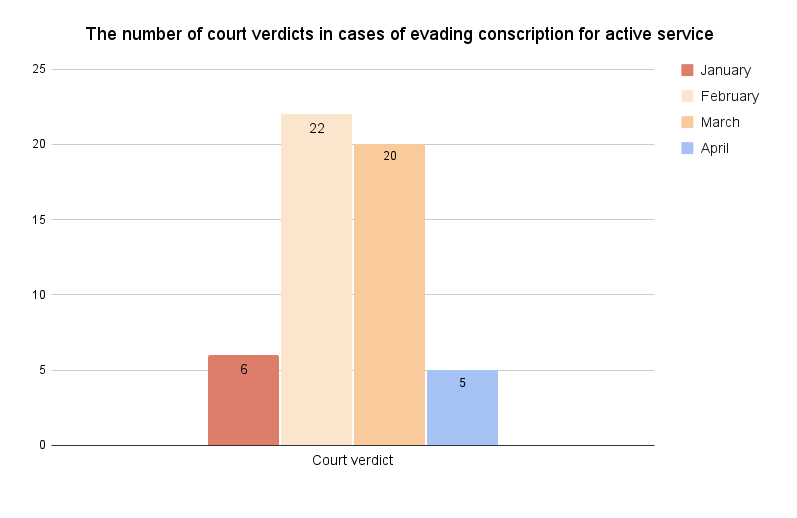
The total amount of expenditures on national defense and mobilization of all budgets of Brest region in 2024 amounted to ≈ $ 4.89 million. This is 4.7 times more than in 2023. The largest expenditures are planned in Brest, Baranavichy, Pinsk, and in Kobryn district. These budgets account for 90% of expenditures of the whole region. The planned expenditures will allow not only to finance the current activities of local authorities in the field of national defense, but also to continue investing in it.
1.5. Military training sessions with reservists
Training sessions with reservists were reported in the following units in April:
- The 110th Material Support Regiment (15 reservists);
- The 557th Engineering Brigade (15 reservists);
- the 1371st Engineering Base;
- The 391st Artillery Ammunition Base;
- The 60th Signal Regiment;
- The 153rd Radio Technical Brigade (special forces) (72 reservists);
- The 74th Signal Regiment (13 reservists);
- The 108th Material Support Regiment (30 reservists);
- The 48th Separate EW Battalion (6 reservists);
- The 3rd School for Tank and Artillery Units (36 reservists);
- The 12th School for the Training of Specialists of Communication Units (12 reservists);
- The 25th Missile and Artillery Armory Arsenal (100 reservists);
- The 46th Rocket and Ammunition Arsenal (11 reservists);
- The 111th Artillery Brigade (19 reservists);
- The 8th Brigade of Nuclear, Chemical and Biological Protection (30 reservists).
240 reservists were drafted to military training sessions to take part in command-staff drills with technical support units. Of these, 100 were assigned to the 25th Missile and Artillery Armory Arsenal.
In total, at least 499 reservists were drafted to the units mentioned.
There was also information about military commissariats of Brest and Minsk regions sending reservists to military training sessions. A total of 81 reservists were sent to training sessions.
About 150 people were also drafted to the training session of the territorial troops in Vileika district. At least 50 reservists were drafted to the training and methodological session at the 1st Militia Brigade of the Internal Troops.
According to clarified information:
- In March, not 7, but 24 reservists were drafted to the 120th Mechanized Brigade for a training session.
- In March, as part of the combat readiness inspection, not 1000 but 1500 reservists were drafted to the 120th Anti-Aircraft Missile Brigade.
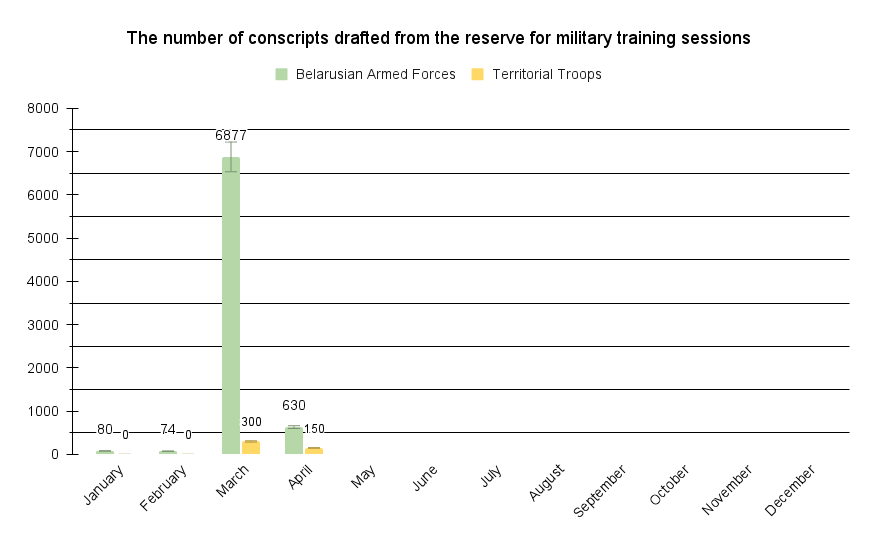
Thus, the total number of reservists drafted to military training sessions in April can be at least 780 people. We note that this is the minimal number of reservists who have undergone military training sessions. In reality, their number may be several times higher, since open sources publish only fragmentary data on conscription to military training sessions.
The Ministry of Defense of Belarus hasn’t reported the number of conscripts to be drafted to military training sessions in 2024. A total of 9000 people were planned to be drafted to training sessions in 2023.
1.6. Rearmament and activity of the military-industrial complex
Supplies of new military equipment to the troops
The following new equipment was reported to be supplied to the troops in April:
1) On April 7, four new Mi-35M helicopters arrived at Machulishchy airfield. This is the second batch of the helicopters (the first one arrived in August 2023). A total of 8 such helicopters are in service with the 50th Combined Air Base of the Belarusian Air Force.
2) JSC Agat – Electromechanical Plant supplied the Belarusian Armed Forces with another batch of the Sosna-2 R-414MBRP radars. The exact number of the radars wasn’t mentioned. The last time such stations were delivered to the army in November 2023.
3) The state media reported that the 377th Anti-Aircraft Missile Regiment of the Belarusian Armed Forces had been rearmed with the S-400 SAM systems. Officially, the Ministry of Defense of Belarus didn’t comment on the transfer of the S-400 systems to the regiment. In 2022-2023, Russia transferred a regiment set (two divizions) of the S-400 systems to Belarus.
4) Propagandists of VoyenTV said that the troops began receiving T-72BM2 tanks modernized in Belarus. Earlier it was reported that serial modernization of the T-72BM2 tank would begin in 2023, and the first 20-30 vehicles would arrive to the troops. However, this didn’t happen. Later it was reported that the army would receive the first modernized tanks this year. So far, there has been no official information about the delivery of the tanks to the troops.
Plans on rearmament were also announced:
1) On April 5, the Ministry of Defense of Belarus published a tender for the purchase of 13 Supercam S350 UAVs. This is the largest one-time purchase of Supercam UAVs.
2) The Ministry of Defense of Belarus is planning to purchase the Berkut-3 short-range tactical reconnaissance unmanned aerial systems made in Belarus. It is planned to spend about $2.44 million for the purchase of drones. An important feature of Berkut-3 is the ability to transmit information to the fire control systems of the Tsenturion 1V12-1AB artillery divizion. For this reason, Berkut-3 will be supplied to artillery units.
3) In 2024, the Ministry of Defense of Belarus is planning to increase the supply of mobile communication systems. A total of 174 sets are to be delivered to the troops.
Activity of the military-industrial complex
1) OJSC KB Radar is developing new Nebosklon and Rodnik-3D radars. Nebosklon is capable of detecting at least 250 targets simultaneously at a range of about 500 kilometers. The Rodnik-3D radar can detect and automatically track small-sized targets (e.g., UAVs) at a range of up to 10 kilometers.
3) The Belarusian military is engaged in the development of laser weapons. No other details about the development have been reported yet.
4) ALEVKURP OJSC is finalizing the production of the PU-12ML mobile control stations. The products are designed for fire control of military air defense units.
1.7. Development of military infrastructure. Formation (re-organization) of new units. Training of military personnel
Development of military infrastructure
The systematic expansion of the network of border outposts on the southern border of Belarus continues. The construction of a new border outpost on the border with Ukraine in Kamaryn (Brahin district) is underway. The outpost will be the seventh to be built in Homiel region since 2022.
Formation (re-organization) of units.
The Grom special forces detachment was formed on the basis of the 5th Militia Brigade of the Internal Troops (military unit 6713). The detachment became the 12th such unit formed since 2022. The tasks of the detachment are to search for and eliminate illegal armed formations and sabotage and reconnaissance groups, to assist in the protection of the state border, etc. The detachment has more than 60 people. The unit is armed with armored vehicles, mortars, anti-tank missile systems, automatic grenade launchers, UAVs of various types, etc.
Training of military personnel
1) On April 26, the 34th graduation of officers took place at the Faculty of Advanced Training and Retraining of Personnel of the Military Academy. The training was completed by 79 servicemen, 21 of whom were women.
The courses for training junior officers have been functioning since 2006. During this period, more than two thousand people have been trained. The training of servicemen at the courses is one of the sources of staffing the Belarusian Armed Forces with officers.
2) On April 29, decree No. 179 “On conscription of reserve officers for military service” was published. The document stipulates that in 2024, reserve officers under the age of 27, who have graduated from the military department and have not completed compulsory military service, will be drafted to the Belarusian Armed Forces and the Border Guard Service. The number of drafted officers is given in a classified annex to the decree. This is the second case in 30 years of reserve officer conscription in sovereign Belarus, when the number of conscripted officers was classified. This may be due to: 1) reluctance to show the deficit of junior officers in the army; 2) the need to conceal the formation of a personnel reserve for the forming Southern Operational Command.
1.8. Tactical nuclear weapons
On April 25, speaking at the All-Belarusian People’s Assembly, Aliaksandr Lukashenka said that several dozens of nuclear warheads – aircraft bombs and warheads for missiles – were placed in Belarus. Earlier it was reported that re-equipped Su-25 attack aircraft and Iskander-M missile systems would become carriers of TNWs, which were to be delivered to Belarus.
We should note that the issues of the use of nuclear weapons have been covered in the new Military Doctrine (for more details, see paragraph 1.9 of the review).
Currently, there is still no reliable data that would confirm the presence of TNWs on the territory of Belarus. Political statements regarding TNWs in Belarus made by Lukashenka, his officials and ‘experts’ can’t be trusted.
1.9. Amendments to legislation in the military sphere
1) On April 5, it became known that the draft law “On suspension of the Treaty on Conventional Armed Forces in Europe” was submitted to the House of Representatives of the National Assembly. The document provides for the suspension of the treaty, but doesn’t mean Belarus’ withdrawal from it and the cessation of internal procedures in the Belarusian Armed Forces related to its implementation. Earlier, Belarus suspended the Treaty on Conventional Armed Forces in Europe with regard to Poland and the Czech Republic. On April 23, the draft law was approved by MPs.
2) According to Decree No.154 of April 15, 2024, the Department for Operational and Investigative Activities of the Ministry of Internal Affairs was renamed (reorganized) as the Department of Criminal Intelligence.
3) On April 24-25, the All-Belarusian People’s Assembly was held. The delegates of the assembly approved the National Security Concept and the Military Doctrine. In particular, the updated Military Doctrine stipulated that Belarus considers the deployment of Russian nuclear weapons on its territory as a tool to “deter potential enemies from unleashing armed aggression.” The doctrine also stipulates that Belarus considers any actions with the use of force directed against the member states of the Union State (Russia and Belarus) as an encroachment on the Union State as a whole and will take “appropriate retaliatory measures.” These regulations were not included in the previous version of the Doctrine of 2016.
For more details on the documents, see the report of May 2, “New National Security Concept and Military Doctrine were approved in Belarus.”
1.10. International cooperation
1) A Cuban military delegation paid a working visit to Belarus. During the visit, the delegation held negotiations with Commander of the Belarusian Air Force and Air Defense Forces Andrei Lukyanovich and Chief of the General Staff of the Belarusian Armed Forces Viktar Hulevich. The parties exchanged views on further cooperation. The Cuban delegation also visited the 61st fighter air base in Baranavichy. Recently, Belarus and Cuba have been intensifying their cooperation in the military sphere.
2) On April 22, an Iranian military delegation headed by the Deputy Minister of Defense and Logistics of the Armed Forces of Iran paid a visit to Belarus. The delegation visited the Research Institute of the Belarusian Armed Forces and the Military Academy, met with the leadership of the institutions and got acquainted with the training material base. During the visit, the parties discussed areas for further joint work in the field of military science and education.
3) On April 23-26, an Egyptian military delegation led by the head of the General Directorate of Combat Training and Military Education of the Egyptian Armed Forces paid an official visit to Belarus. During the visit, the delegation met with the head of the Main Directorate of Combat Training of the Belarusian Armed Forces. The representatives of the Egyptian delegation also visited military educational institutions of Belarus. The parties outlined prospects for further cooperation in the field of military personnel training.
4) Chief of the General Staff of the Belarusian Armed Forces Viktar Hulevich paid an official visit to Uzbekistan. During the visit, he held negotiations with the Chief of the General Staff of the Armed Forces of Uzbekistan. The two parties discussed the current state of bilateral military cooperation and outlined ways to intensify it in areas of mutual interest. Hulevich also visited a number of educational institutions of Uzbekistan, where he got acquainted with the structure, tasks and system of military personnel training, training material base.
1.11. Combat readiness inspection
On April 1, the Ministry of Defense of Belarus reported that command and staff drills with the 336th Rocket Artillery Brigade started as part of the combat readiness inspection. As part of the drills, the brigade’s units carried out a set of measures to prepare and conduct combat operations: they marched to new position areas, relocated the command post, and fought against enemy’s sabotage and reconnaissance groups.
On April 9-11, tactical drills were conducted with the 19th Mechanized Brigade. The drills were a key stage of the combat readiness inspection. The units practiced defensive actions: repulsing the offensive of the conditional enemy, destroying illegal armed formations, sabotage and reconnaissance groups, etc. The soldiers also practiced covering an important state facility with air defense equipment.
The idea of the drills included the issues of using UAVs for reconnaissance. Another feature of the drills was the practical use of weapons and equipment of the self-propelled artillery divizion battery of the Strela-10 SAM system, as well as working out interaction with the border guard bodies.
The drills were conducted in Vitsiebsk, Hrodna, Brest and Mahiliou regions. Lepelski, Asipovichski, Damanava training grounds, as well as terrain in the Ashmiany and Pastavy districts were used for the drills.
After the drills ended, the units of the 19th Mechanized Brigade began to return to their permanent deployment point. Dismissal of conscripts drafted to the military training session also began.
On April 10-11, tactical drills were held at the Damanava training ground with units of the 120th Anti-Aircraft Missile Brigade. For the first time, drills involving a large number of reservists were conducted in the Air Defense Forces.
During the drills, crews of the Buk SAM system performed air defense combat duty tasks. New ways of using SAM systems were practised. The crews of the ZU-23-2 and Igla systems provided direct cover for launch positions. Much attention was paid to repelling enemy air attacks, including UAVs, improving the survivability of units, and countering sabotage and reconnaissance groups.
According to officials of the Ministry of Defense of Belarus, the peculiarities of the inspection were:
- Involvement of instructors who were trained in Russia to train reservists. Thanks to this, it was possible to adopt modern combat experience and make a qualitative leap in the level of readiness of the personnel.
- The troops tested new ways of using military equipment. For example, during the drills, much attention was paid to countering means of air attack (including UAVs), improving the survivability of units, and countering sabotage and reconnaissance groups.
We should note that it was not formally reported that the combat readiness inspection, which started on March 11, had been completed. Therefore, new inspection activities can be expected in the coming months.
Chapter 2. Armed Forces of the Russian Federation
2.1. Russian group in Belarus
The situation with the group of the Russian Armed Forces in Belarus didn’t change in April compared to previous months.
Russian military continue to be stationed at Mazyr (Bokau) and Ziabrauka airfields. According to available information, one anti-aircraft missile divizion of the 1530th Anti-Aircraft Missile Regiment of the Russian Armed Forces (military unit 31458) is stationed at each of the airfields. The regiment is part of the Eastern Military District and was redeployed to Belarus to take part in the Union Resolve-2022 drills back in early February 2022.
The number of equipment located at the airfields hasn’t changed over the past month.
The fact of the presence of the Russian military at Ziabrauka airfield is confirmed by regular movements of vehicles of the Russian Armed Forces in Mazyr and its vicinity. So far, it hasn’t been publicly reported in what status the Russian military are present at the airfields.
On April 25-26, two military transport aircraft of the Russian Aerospace Forces arrived at Homiel airport. We note that the airport is used to supply the Russian Armed Forces units stationed at Ziabrauka and Mazyr (Bokau) airfields, as well as to ensure their rotation. It is possible that the arrival of the aircraft was connected with another rotation of the Russian contingent located at Ziabrauka and Mazyr (Bokau) airfields. Previously, we recorded the rotation of the Russian military in December 2023.
Thus, as of May 1, 2024, the number of Russian military personnel stationed in Belarus didn’t change and can be estimated at about 2000 people. Of these:
- at Baranavichy, Mazyr (Bokau) and Ziabrauka airfields – 500-600 people;
- at the 474th Baranavichy separate radio-technical node (70M6 Volga radar station, military unit 03522) and Russian Navy’s 43rd Vileika communication center (military unit 49390) – up to 1450 people.
Also, the following Russian military law enforcement agencies continue to work in Belarus: the 484th Military Investigation Department (Kletsk district, Minsk region) and the 313th Military Prosecutor’s Office of the garrison (Minsk). The number of personnel involved in these structures could be estimated at dozens of people.
2.2. Movements of military equipment and aviation activity.
The intensity of movements of military equipment on public roads didn’t change compared to March. Regular movements of equipment of the Russian Armed Forces have been recorded mostly in Mazyr and its vicinity. More details on the movements of military equipment are available on the map.
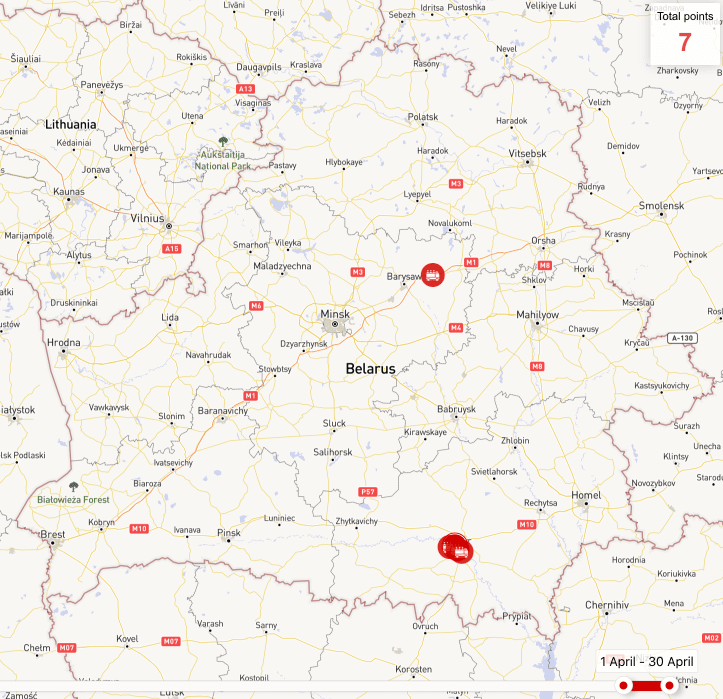
No movements of the Russian Armed Forces by rail were recorded in April.
Aviation activity of the Russian Aerospace Forces decreased more than two-fold in April compared to March. Transport aircraft of the Russian Aerospace Forces kept arriving at the airfields of the Belarusian Armed Forces and civilian airports:
- Machulishchy airfield: passenger – 1 Tu-134AK.
- Baranavichy airfield: transport – 1 An-12, 1 An-124.
- Homiel airport: transport – one An-12, 1 An-26.
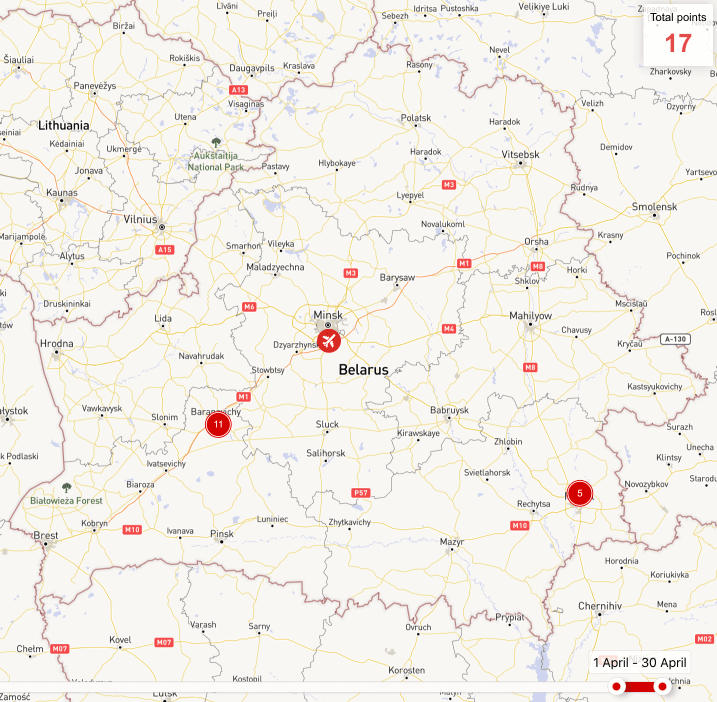
We should note that the arrivals of not all the aircraft mentioned above were related to military purposes. For example, the An-124, which arrived at Baranavichy airfield from Bangladesh, could have delivered a fighter aircraft for repair (modernization) to the 558 Aircraft Repair Plant. Therefore, in this case it is rather a question of commercial flights.
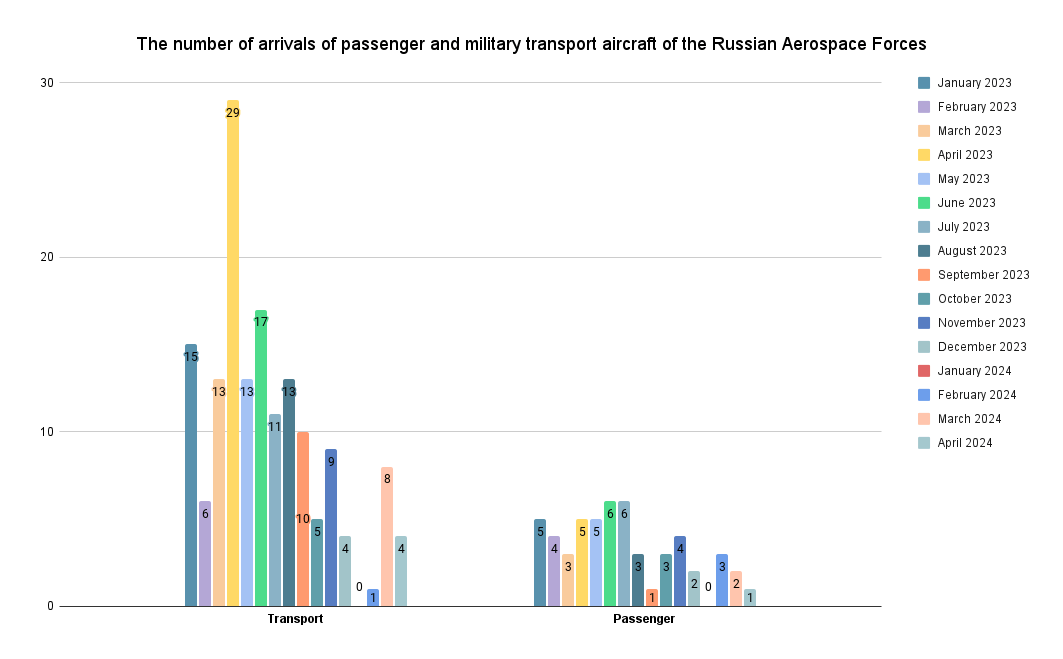
We can also note that on April 10, 11, 12 and 18, flights of fighters of the Russian Aerospace Forces were recorded at Baranavichy airfield.
On April 23, a Su-30SM fighter of the Russian Aerospace Forces arrived at Baranavichy airfield from Russia. Thus, as of May 1, the following aircraft of the Russian Aerospace Forces are permanently stationed on the territory of Belarus:
- at Lida airfield – one Su-25 attack aircraft;
- at Baranavichy airfield – two Su-24MR reconnaissance aircraft and at least two Su-30SM fighters.
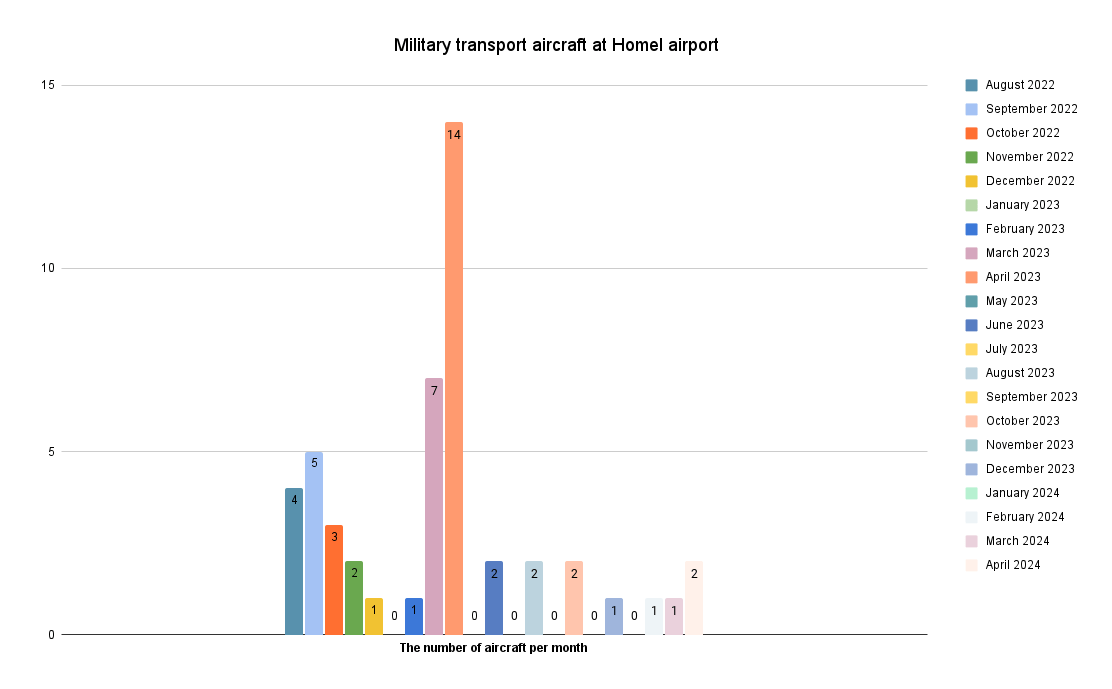
During the month, the arrivals of two military transport aircraft (An-12 and An-26) of the Russian Aerospace Forces at Homel airport were recorded. The dynamics of arrivals of the Russian Aerospace Forces aircraft from August 2022 to April 2024 can be seen in the chart. As can be seen, since May 2023, an average of up to 2 aircraft have been arriving at the airport every month.
In our March 2024 review, we wrote that due to the extension of the flight restriction zone for civil aircraft in southern Belarus, the potential threat of missile strikes from the territory of Belarus remains. On the night of April 26-27, several Russian missiles launched at targets in Ukraine from the territory of Russia flew over Homiel region of Belarus.
We should note that no anti-aircraft missile units of the Belarusian Armed Forces are stationed on the territory of Homiel region – only those of the Russian Armed Forces (for more details, see paragraph 2.1 of the review). At the same time, units of the Radio-Technical Troops of the Belarusian Armed Forces (the 1052nd Separate Radio-Technical Battalion) are stationed on the territory of the region.
Chapter 3. Wagner private military company
The situation with the mercenaries in Belarus hasn’t changed compared to February and March.
We can state that after Lukashenka’s statements about the need to stop praising PMC Wagner, there was a change of media policy with regard to the mercenaries. Recently, the number of references to PMC Wagner by official resources has significantly decreased. For example, the press service of the Internal Troops stopped mentioning PMC Wagner in general.
The number of the mercenaries in Belarus could be estimated at hundreds of people. As before, the mercenaries continue to train Belarusian security forces. The special feature of recent months is the intensification of cooperation of the mercenaries with the Belarusian Armed Forces (for more details, see paragraph 1.1 of the review).
General conclusions
- The combat readiness inspection continued to be the main event of April for the Belarusian Armed Forces. The inspection was the largest in the history of the Belarusian Armed Forces. The total number of reservists drafted to military training sessions from the reserve (about 6500) is unprecedented.
The approval of the new National Security Concept and Military Doctrine was also significant. Both documents have undergone significant changes and documented the military-political changes that have taken place in Belarus in recent years.
The ongoing process of rearmament of the Belarusian Armed Forces should also be mentioned. The main event of April was the arrival of the second batch of four Mi-35M helicopters to the Belarusian Air Force. In total, the 50th Combined Air Base is to receive a squadron (12 helicopters). We can note that these deliveries are being carried out, but with a delay from the originally announced deadlines.
The number of tactical UAVs continues to increase in the troops. The planned procurement of UAVs in 2024 significantly exceeds the volume of procurement of this equipment in previous years. In addition to Russian UAVs (Supercam), procurement of Belarusian-made equipment will begin in the near future.
The general direction of the national security activities implemented by the Lukashenka regime indicates an increasing (in the regime’s opinion) probability of Belarus’ participation in the war.
- The general conclusion about the situation with the Russian Armed Forces on the territory of Belarus didn’t change. All the conclusions given in the review for February remain valid.
The level of activity of the Russian Armed Forces in Belarus in April can be described as low.
- All the conclusions regarding the prospects for the deployment of PMC Wagner mercenaries in Belarus given in the review for October 2023 remain valid. A small number of the mercenaries are still stationed in Belarus, who serve as instructors for Belarusian military structures. There are no signs of a complete shutdown of mercenaries’ activities in Belarus.
The level of activity of PMC Wagner in Belarus in April can be described as low.
